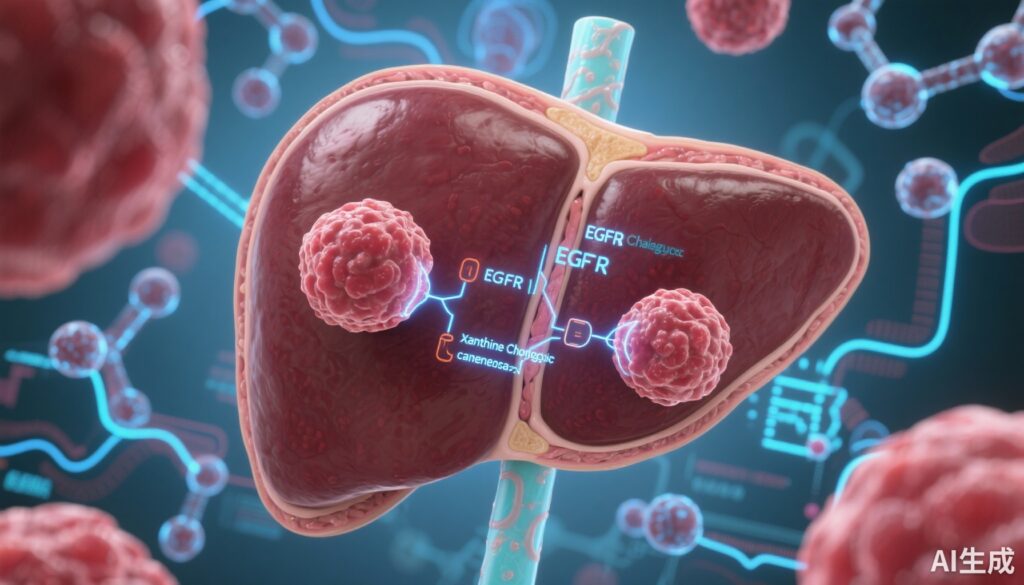Highlight
- Xanthine oxidoreductase (XOR) is identified as a key mediator of resistance to EGFR tyrosine kinase inhibitors (TKIs) in intrahepatic cholangiocarcinoma (iCCA).
- XOR promotes EGFR protein stability via USP8-mediated deubiquitination and upregulates MUC1, enhancing oncogenic signaling and DNA damage repair.
- Knockdown or inhibition of XOR reduces tumor proliferation, exacerbates DNA damage, and significantly increases sensitivity of iCCA cells to EGFR TKIs like gefitinib.
- Targeting XOR offers a novel therapeutic strategy to overcome TKI resistance and improve outcomes in patients with iCCA, an aggressive liver cancer with limited treatment options.
Study Background
Intrahepatic cholangiocarcinoma (iCCA) is a highly aggressive primary liver cancer arising from the bile duct epithelium within the liver parenchyma. Despite advances in molecular oncology, iCCA continues to have a poor prognosis owing to late diagnosis, rapid disease progression, and resistance to currently available therapies. Epidermal growth factor receptor (EGFR) is frequently overexpressed and aberrantly activated in iCCA, representing a promising target for molecular therapies. However, clinical trials of EGFR tyrosine kinase inhibitors (TKIs) such as gefitinib have failed to demonstrate significant clinical benefit, highlighting the urgent need to understand and overcome mechanisms of resistance. The molecular basis for EGFR TKI resistance in iCCA remains poorly defined, limiting development of effective targeted therapeutic strategies.
Study Design
To elucidate mechanisms of EGFR TKI resistance in iCCA, the investigators employed genome-scale CRISPR-Cas9 chemical-genetic screening in iCCA cell lines treated with EGFR inhibitors. This unbiased approach enabled identification of genetic modulators influencing drug sensitivity. The expression of candidate genes was assessed in human iCCA surgical specimens compared with matched non-tumor peritumor tissue using immunohistochemistry, western blotting, and quantitative reverse-transcriptase PCR. Complementary in vivo models were established using genetically engineered mice with liver-specific conditional knockouts of Xdh (encoding XOR) and somatic oncogenic drivers (myr-AKT with YapS127A or NICD1) delivered through the Sleeping Beauty transposon system. Functional assays assessed tumor cell proliferation, DNA damage, and tumor progression in context of XOR modulation and EGFR TKI treatment. Molecular mechanistic studies characterized the transcriptional regulation of XOR by CEBPβ and its downstream effects on EGFR stability and MUC1 expression.
Key Findings
The CRISPR-Cas9 screens revealed xanthine oxidoreductase (XOR) as an essential factor conferring resistance to EGFR TKIs in iCCA cells. XOR was markedly upregulated in iCCA tumor tissue relative to matched peritumor specimens and bile duct epithelium. Knockdown or genetic ablation of XOR suppressed iCCA cell proliferation and tumor growth, accompanied by increased DNA damage markers. Notably, combining XOR inhibition with gefitinib showed synergistic anti-tumor effects both in vitro and in established murine iCCA models.
Mechanistically, the transcription factor CEBPβ was found to regulate XOR expression, positioning this axis upstream in the drug resistance pathway. XOR enhanced EGFR protein stability via USP8-mediated deubiquitination, preventing proteasomal degradation. Concurrently, XOR upregulated the mucin protein MUC1, which is known to stabilize receptor tyrosine kinases and promote downstream signaling cascades including those involved in DNA repair.
As a result, heightened XOR activity sustained EGFR signaling and enhanced DNA damage repair capacity within iCCA cells, collectively driving resistance to TKIs. Disruption of this XOR-driven pathway reinstated sensitivity to EGFR inhibitors and led to tumor growth suppression.
Expert Commentary
This study addresses a critical barrier in targeted therapy for iCCA by identifying XOR as a pivotal mediator of intrinsic resistance to EGFR TKIs. The application of genome-scale CRISPR screening highlights the power of unbiased functional genomics to unravel complex resistance mechanisms. The elucidation of the XOR–USP8–MUC1 axis provides a compelling molecular rationale for combined therapeutic approaches that inhibit XOR to destabilize EGFR and augment TKI efficacy.
While EGFR overexpression in iCCA has been recognized, this investigation sheds light on why receptor overexpression alone does not translate into clinical TKI responsiveness. Stabilization and repair mechanisms can neutralize the intended effects of EGFR blockade. Importantly, the role of XOR in promoting DNA repair may contribute to tumor cell survival under pharmacologic stress.
Limitations include the need to confirm these findings in larger patient cohorts and explore potential off-target effects or toxicity of XOR inhibition in clinical settings. Additionally, the heterogeneity of iCCA tumors warrants investigation into combinatorial strategies, perhaps integrating XOR inhibitors with other targeted or immune therapies.
Conclusion
This pivotal research identifies xanthine oxidoreductase as a novel and actionable driver of resistance to EGFR tyrosine kinase inhibitors in intrahepatic cholangiocarcinoma. By maintaining EGFR receptor stability through USP8-mediated deubiquitination and upregulating MUC1, XOR enhances oncogenic signaling and DNA damage repair pathways, fostering a resistant phenotype. Therapeutic targeting of XOR sensitizes iCCA cells to EGFR inhibitors, suppresses tumor progression, and could represent a transformative strategy for improving outcomes in a difficult-to-treat malignancy. Future clinical development of XOR inhibitors alongside EGFR TKIs holds promise for addressing a critical unmet need in iCCA management.



